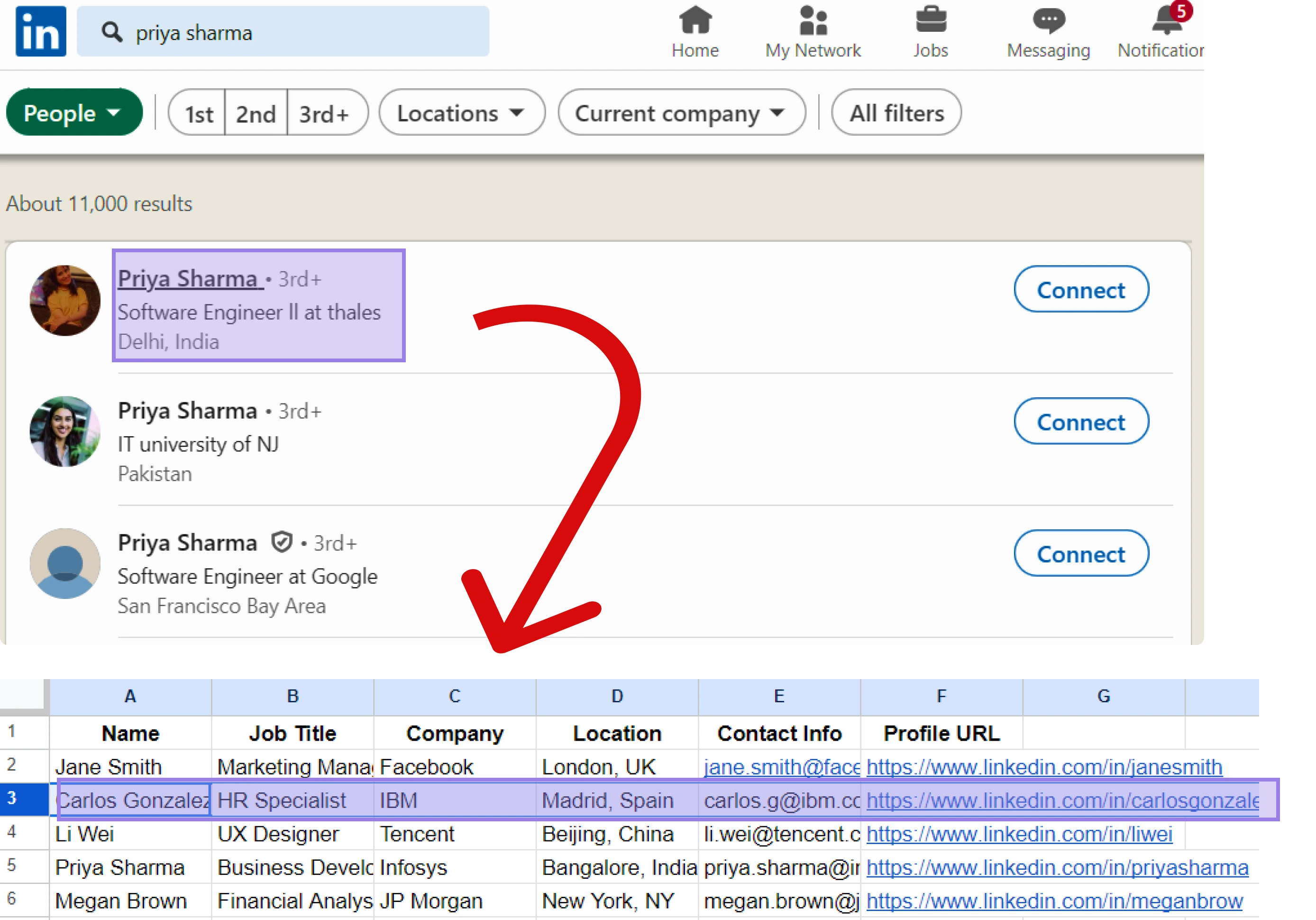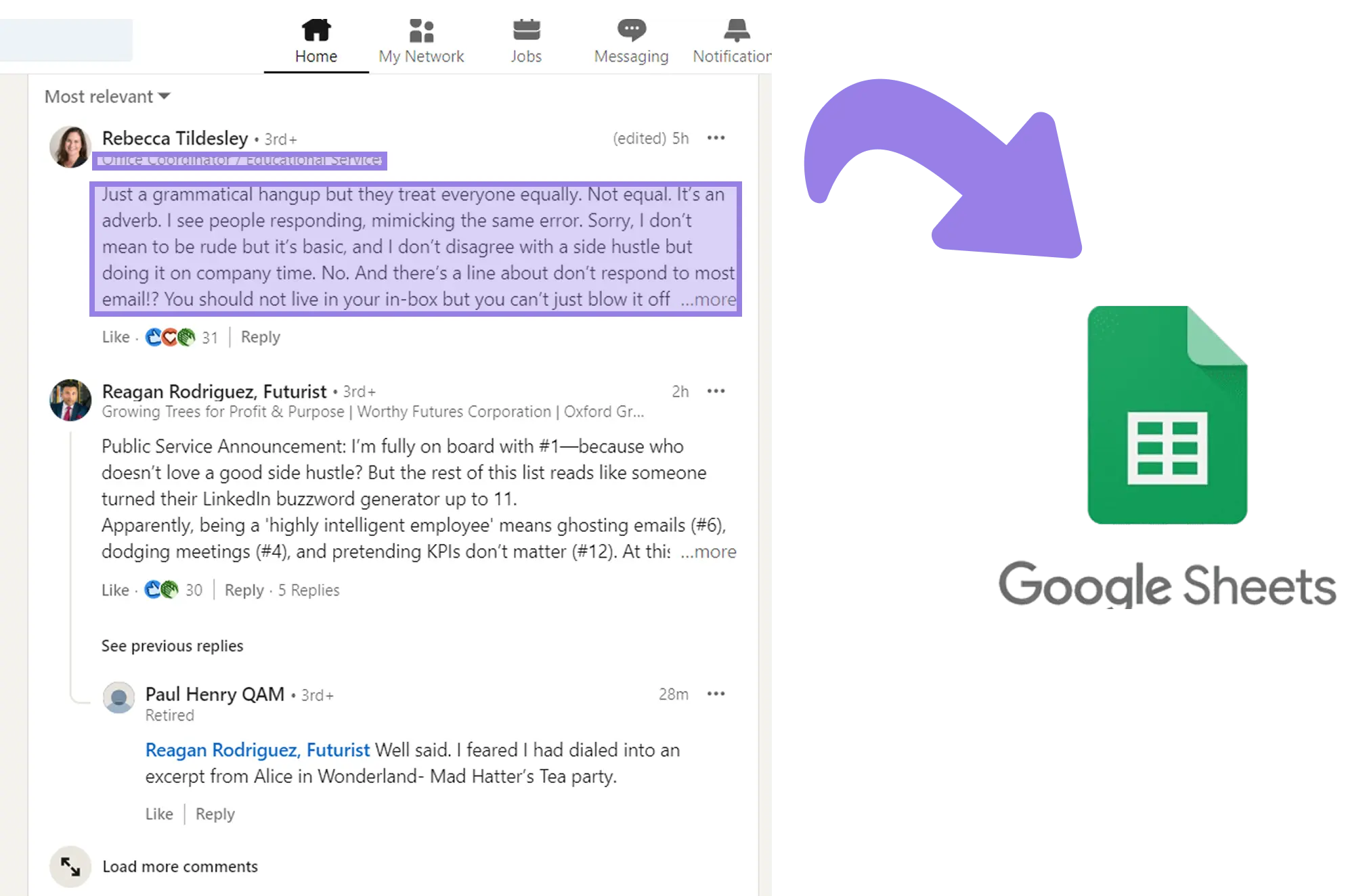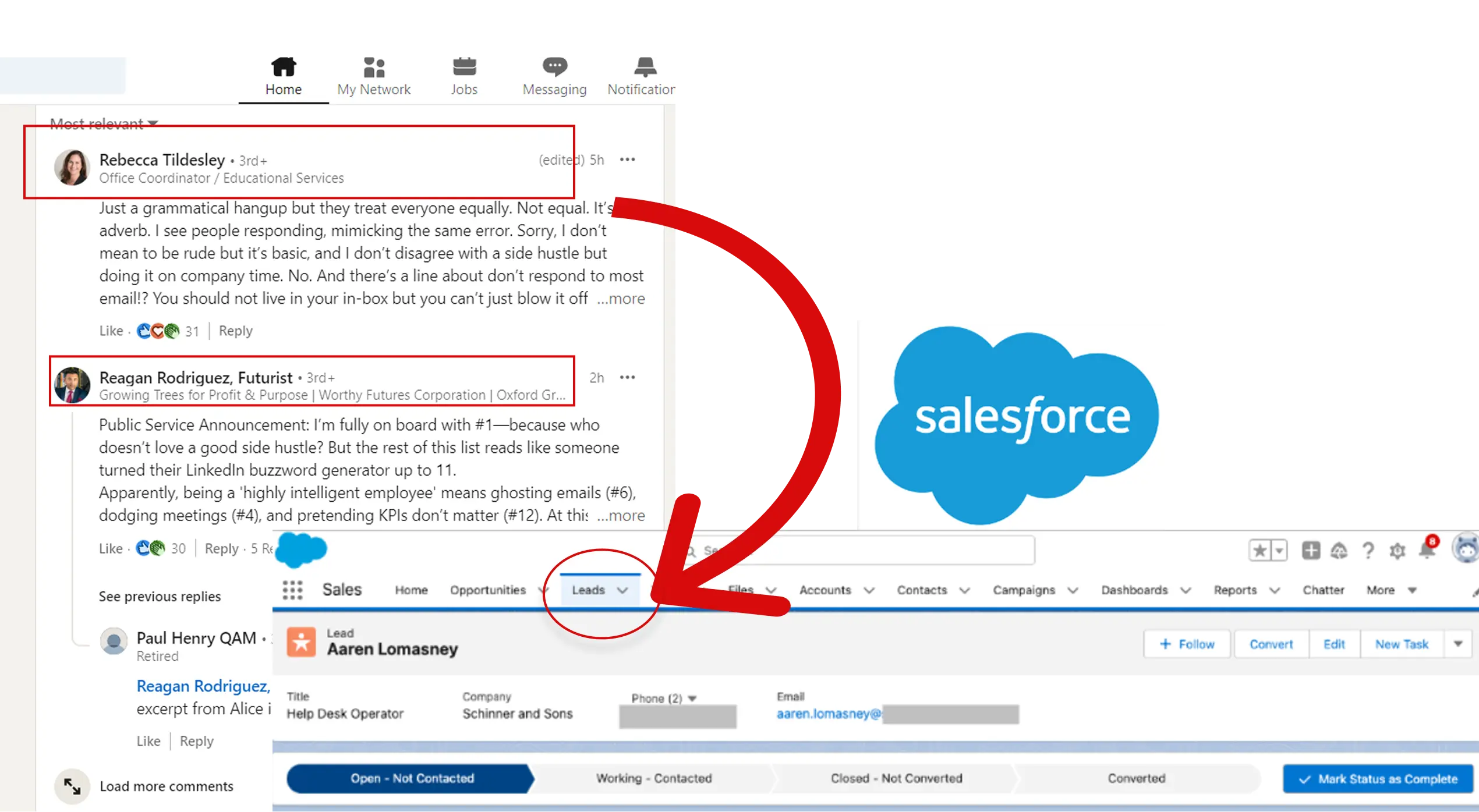Lead enrichment adds valuable information to your existing leads.
By the way, we're Bardeen, we build a free AI Agent for doing repetitive tasks.
If you're in B2B sales, you might be interested in our AI Agent for sales. It automates lead enrichment, saving you time and enhancing lead quality.
Lead enrichment is a critical component of sales success in 2025. It plays a vital role in qualifying sales leads and moving them through the sales funnel for more conversions.
Consider these compelling lead enrichment statistics from Madison Logic:
- Companies that excel at lead nurturing, of which enrichment is a key part, generate 50% more sales-ready leads at 33% lower cost
- Organizations that use lead nurturing have 4-10 times the response and engagement rates compared to those that don't
- 79% of marketing leads never convert into sales due to lack of lead nurturing, which includes lead enrichment
Still, you may have some pressing questions about how to enrich lead data. What is lead enrichment? What are the best lead enrichment tools in 2025? What is LinkedIn enrichment?
In this guide, we'll dive deep into everything you need to know about lead enrichment—including what lead enrichment is, why it matters immensely for sales teams, and how to implement it effectively.
Let’s start at the top.
What is lead enrichment?
Lead enrichment is the process of adding more information to an existing lead record to gain deeper insights about the lead. Why? It enables sales teams to build prospect lists properly, gain a better understanding, and engage with them. Simple.
For example, let's say a software company attends a trade show and collects business cards from interested attendees. The information on the cards is limited to name, company, and email. To qualify and prioritize these leads, the sales team can enrich the data in Google Sheets. This means adding extra details like job title, company size, industry, and technographic info. Here’s a Bardeen template meant to help with exactly that:
They may do this manually by researching each lead online. Or, they may use lead enrichment tools to automatically pull in third-party data. Now the sales reps have much more context about each lead to tailor their outreach.
What is LinkedIn enrichment?
LinkedIn lead enrichment—or, for that matter, lead enrichment from any social media—is the process of enhancing lead data by extracting valuable insights from LinkedIn profiles and company pages.
LinkedIn is a great place to enrich data as it stores a ton of useful details. It also has many in-built features like LinkedIn Sales Navigator to help you along. And Bardeen natively integrates with both, offering automations such as:
Why lead enrichment matters for sales
Enriching leads with additional context equips sales reps to personalize their cold emails and more effectively move leads through the funnel. Complete lead data allows for better lead scoring, segmentation, and prioritization.
Some key benefits of lead enrichment include:
- Improved lead qualification - Identify which leads are the best fit and most likely to convert based on enriched firmographic and demographic data.
- More targeted outreach - Tailor messaging and content to the specific interests, pain points and buying stage of each lead.
- Increased conversion rates - By focusing efforts on the most qualified, sales-ready leads, conversion rates tend to rise significantly.
- Greater sales efficiency - Reps waste less time chasing unqualified leads or doing manual research. Lead enrichment enables them to quickly hone in on the best opportunities.
Why lead enrichment is crucial for B2B sales
B2B sales cycles are long and complex, often involving multiple decision-makers. Lead enrichment provides the information needed to identify key stakeholders, uncover buying signals, and engage leads with relevant messaging. It's an essential process for any B2B sales org looking to boost conversion rates and revenue.
B2B lead enrichment comes with its own challenges and obstacles. Automated lead enrichment tools can seriously slash the amount of time your team has to spend entering data — just think about how many hours the workflows below could save you.
Core types of lead enrichment data
Before we get into how to enrich lead data and the best automated lead enrichment tools available, you should know the core types of data enrichment. To maximize the impact of your lead enrichment efforts, it's crucial to understand the various types of data you can use. This way, you can gain a 360-degree view of your prospects and tailor your outreach accordingly.
Verified contact information for effective outreach
Contact data is the foundation of lead enrichment. It includes essential details like email addresses, phone numbers, and direct dial numbers. Having accurate contact information allows you to reach out to prospects through multiple channels and increases the likelihood of successful engagement.
For example, if you're targeting a decision-maker at a large enterprise, having their direct phone number can help you bypass gatekeepers and initiate a conversation.
Lead enrichment data strength: Strong
Ease of obtaining lead enrichment data type: Medium
Valuable account data for strategic targeting
Account data provides insights into the overall structure and hierarchy of a prospect's organization. It includes information about parent companies, subsidiaries, and key decision-makers within the account.
Imagine you're selling a complex enterprise solution. By understanding the account structure, you can identify the right stakeholders to engage with and tailor your messaging to address their specific needs and pain points.
Lead enrichment data strength: Strong
Ease of obtaining lead enrichment data type: Medium
Insightful intent data to identify ready-to-buy prospects
Intent data reveals a prospect's level of interest and readiness to make a purchase. It includes online behaviors like website visits, content downloads, and search queries related to your product or service.
Let's say you notice a prospect has visited your pricing page multiple times and downloaded a case study. This intent data suggests they are actively evaluating solutions and may be ready for a sales conversation.
Lead enrichment data strength: Strong
Ease of obtaining lead enrichment data type: Medium
Behavioral data to understand prospect engagement
Behavioral data tracks a prospect's interactions with your brand across various touchpoints. It includes email opens, link clicks, website visits, and event registrations.
Imagine you send a prospect an email invitation to a webinar. If they open the email, click the registration link, and attend the webinar, that behavioral data indicates a high level of engagement and interest in your content.
Lead enrichment data strength: Medium
Ease of obtaining lead enrichment data type: Easy
Demographic data for targeted messaging
Demographic data provides insights into a prospect's personal characteristics, such as age, gender, income level, and education. This information can help you create targeted messaging that resonates with specific audience segments.
For example, if you're selling a luxury product, knowing a prospect's income level can help you determine if they are a good fit for your offering and tailor your messaging accordingly.
Lead enrichment data strength: Low
Ease of obtaining lead enrichment data type: Medium
Firmographic data for ideal customer profiling
Firmographic data focuses on the characteristics of a prospect's company, such as industry, company size, revenue, and location. This information helps you identify ideal customer profiles and target companies that align with your product or service.
Let's say your solution is designed for mid-sized businesses in the healthcare industry. By enriching your leads with firmographic data, you can quickly identify prospects that match those criteria and prioritize your outreach efforts.
Lead enrichment data strength: Strong
Ease of obtaining lead enrichment data type: Easy
Technographic data to identify technology compatibility
Technographic data provides insights into the technologies and tools a prospect's company uses. This information is particularly valuable for B2B sales, as it helps you understand if your product or service is compatible with a prospect's existing tech stack.
For instance, if you sell a marketing automation platform, knowing that a prospect already uses a specific CRM system such as HubSpot or Salesforce can help you highlight the native integration capabilities of your solution.
Lead enrichment data strength: Medium
Ease of obtaining lead enrichment data type: Medium
Geographic data for localized outreach
Geographic data includes information about a prospect's location, such as city, state, and country. This data is useful for tailoring your outreach based on regional preferences, regulations, or events.
Imagine you're hosting a series of in-person workshops across different cities. By enriching your leads with geographic data, you can invite prospects located near each event venue, increasing the likelihood of attendance.
Lead enrichment data strength: Low
Ease of obtaining lead enrichment data type: Easy
Want to gain a holistic view of your prospects and create targeted outreach that resonates? Use as many of these nine types of lead enrichment data as it makes sense for your audience.
How to enrich lead data
Lead enrichment involves both factors within your control and external factors that are beyond your influence. While you can optimize your internal processes and utilize lead enrichment tools, there are situations where lead enrichment may not yield the desired results, no matter how much effort you put in.
- When a lead provides false or misleading information during the data collection process, making it challenging to enrich their profile accurately.
- When a lead's contact information changes frequently, such as in cases of job transitions or company mergers, making it difficult to keep their data up-to-date.
- When a lead actively opts out of data enrichment or requests their information to be removed, limiting your ability to gather additional insights.
To help sales professionals make the most of lead enrichment, we've put together a detailed step-by-step guide. So, let’s see how to enrich lead data more effectively:
Gather essential prospect information
The first step? Collect relevant data about your prospects. This includes basic contact information such as email addresses and phone numbers, as well as firmographic and demographic data.
By gathering a wide range of data points, you can create a more complete profile of each lead, enabling you to customize your outreach and improve your chances of success.
Strategies for effective data collection:
- Use web forms and landing pages to capture lead information.
- Integrate with third-party data providers to access additional insights.
- Encourage leads to provide more information through incentives or gated content.
- Regularly update and verify existing lead data to ensure accuracy.
Without a solid foundation of accurate data, subsequent B2C and B2B lead enrichment efforts may be less effective. And you know what that means: wasted time and wasted resources.
Assign leads to the right sales reps
Once you’ve collected and enriched your lead data, it's crucial to route leads to the most appropriate sales representatives. This process, known as lead routing, ensures that each lead is handled by the rep best equipped to address their specific needs and concerns.
Effective lead routing takes into account factors such as industry expertise, geographic location, and past performance, allowing you to optimize your sales team's efficiency and productivity.
Strategies for successful lead routing:
- Define clear criteria for lead assignment based on rep strengths and specialties.
- Implement an automated lead routing system to streamline the process.
- Regularly review and adjust routing rules based on performance data.
- Provide sales reps with the necessary context and insights to engage leads effectively.
Failing to route leads properly can result in missed opportunities, longer sales cycles, and lower conversion rates.
Turn prospects into customers
With enriched lead data and optimized routing in place, your sales team is well-positioned to convert prospects into customers. After all, conversion is the ultimate goal of the lead enrichment process. And that requires a strategic approach, aided by the insights gained from enriched data.
By understanding each lead's unique needs, preferences, and behaviors, sales reps can craft personalized outreach that resonates and drives action.
Strategies for improving lead conversion:
- Tailor messaging and offers based on lead enrichment data.
- Prioritize leads based on intent signals and engagement levels.
- Tap into multiple channels, such as email, phone, and social media, to engage leads.
- Continuously monitor and optimize conversion rates based on performance data.
Without a focus on conversion, even the most well-enriched leads may fail to generate revenue for your business.
Build long-term relationships with leads
Lead enrichment doesn't end with conversion. To maximize the lifetime value of your customers, it's essential to continue nurturing leads — ideally using automated lead enrichment tools — long after the initial sale.
With enriched data, you’ll understand each customer's evolving needs and preferences, and you can deliver ongoing value and support, fostering loyalty and driving repeat business.
Strategies for effective lead nurturing:
- Segment customers based on enriched data to deliver targeted content and offers.
- Regularly update and enrich customer data to ensure relevance.
- Engage customers through personalized touchpoints, such as email campaigns and customer success outreach.
- Monitor customer satisfaction and proactively address concerns or issues.
Neglecting lead nurturing can lead to higher churn rates and missed opportunities for upselling and cross-selling.
This step-by-step guide is a great reference for anyone wanting to enrich lead data and scale their sales efforts. From data collection to lead nurturing, each stage plays a critical role in the overall success of your sales process. And it will, in the long run, help you close more deals!
Manual processing vs. automated lead enrichment tools
Manual lead enrichment involves researching and adding information to lead records by hand. On the other hand, automated lead enrichment tools use tech to do it instead. Sales teams should carefully consider which approach best fits their needs and resources.
For manual enrichment, a sales rep might look up a lead's LinkedIn profile to find their job title and add it to the CRM. This allows for a personal touch but is time-consuming and unscalable.
In contrast, by integrating with your favorite CRM, a tool like Clearbit can automatically enrich leads with data like job title, company size, industry, and more. This enables enrichment at scale with minimal manual effort. However, automated tools may lack the nuance of human research.
Lead enrichment tools are worth the investment for most teams to gather key insights at scale. Here are some of the time-saving automations Bardeen offers out-of-the-box:
The 4 benefits of lead enrichment for B2B marketing
Lead enrichment provides numerous benefits for sales and marketing teams looking to boost their performance and close more deals. By understanding these key advantages, you can optimize your sales process and achieve better results. Let’s take a look:
More context from enriched lead data prevents stale information
Enriching leads with additional data points like job title, company size, and industry gives reps valuable context. This helps avoid relying on outdated or incomplete information that can derail sales efforts.
Focused sales funnels enable personalized outreach at scale
With enriched lead data, sales teams can zero in on the most promising prospects. Reps can tailor messaging and outreach based on key attributes, making their communications more relevant and impactful, even when dealing with a high volume of leads.
Faster speed to lead drives higher conversion rates
Enriched lead data accelerates the process, especially if you also use lead qualification tools. Reps can quickly identify sales-ready leads and engage them in a timely manner. Prompt outreach when a lead is "hot" maximizes the likelihood of conversion.
Automated enrichment eliminates manual work for maximum efficiency
Lead enrichment tools automate the time-consuming process of manually researching and updating lead records. This frees up reps to focus on revenue-generating sales activities. Automated enrichment ensures data is always accurate and actionable.
The benefits of lead enrichment are clear - more context, personalization at scale, faster lead engagement, and increased sales efficiency.
Closing
The fact is, lead enrichment is a crucial component of the sales process, enabling sales teams to make informed decisions and personalize their outreach for better results.
In this guide, we covered:
- The definition and importance of lead enrichment in the context of sales and lead qualification.
- The core types of data that can be used to enrich leads and their relative strengths.
- A step-by-step process for effectively enriching leads and maximizing sales success.
- The differences between manual lead enrichment and the benefits of using lead enrichment tools.
- The key advantages of implementing lead enrichment tools in your sales process.
With lead enrichment, sales professionals can unlock the full potential of their leads and close more deals with qualified contacts. After all, a well-enriched lead is like a well-seasoned dish – irresistible!


















.svg)
.svg)
.svg)

Social media data for personalized engagement
Social media data provides valuable insights into a prospect's interests, preferences, and professional network. It includes information from platforms like LinkedIn, Twitter, and Facebook.
For instance, if you discover a prospect is actively engaged in industry-specific LinkedIn groups, you can use that information to craft a personalized outreach message that resonates with their interests and establishes a connection.
Lead enrichment data strength: Medium
Ease of obtaining lead enrichment data type: Easy